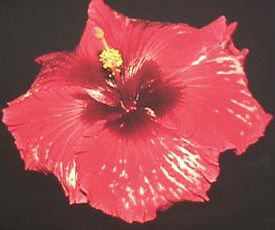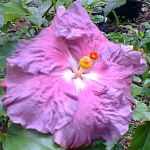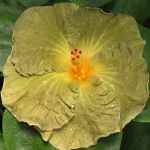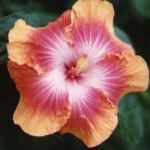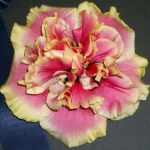|
While the flowers on these pages may be very enticing, you may
look out your window, see snow and ice, and wish you were living in
south Florida, Hawaii, Singapore or some other tropical area where you
could grow tropical hibiscus.
Tropical hibiscus need a lot of light to bloom and
perform well. Full sun from dawn to dusk may be too much during summer,
but during short winter days, they need all the light they can get.
Even with a lot of light and ideal temperature and humidity during the
winter, they will likely bloom and grow less.
Before we get into it, many
people want to know, "How do I tell if I Have a Hardy Hibiscus or a
Tropical Hibiscus?" and "Will My Hibiscus Overwinter Outside?"
You need to know which one you
have. Unfortunately, garden centers, nurseries and home improvement
centers lump all hibiscus together.
If your hibiscus has glossy deep green leaves, 3-6" flowers of red, pink, orange, yellow, double or
single flowers, it is probably a TROPICAL hibiscus. While many common
garden varieties have the 3-6" blooms, many of the hybrid varieties of
tropical hibiscus can have blooms around 10" in diameter under ideal
conditions.
Another way to check is if the
flowers are salmon, peach, orange, or yellow, or double flowered, then
you probably have a TROPICAL hibiscus. Hardy hibiscus do not come in
these colors or in doubles! Many tropical hibiscus flowers have more
than one color in a bloom either in bands or as spots.
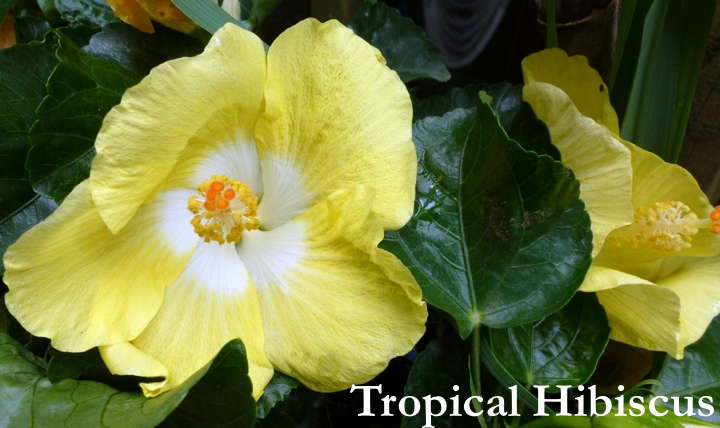
If your hibiscus has dull medium green heart shaped leaves, dinner plate sized white, pink or red
flowers with HUGE, bomb shaped buds (2-4" in length!), it is a
perennial, hardy hibiscus.
Hardy hibiscus need very
little care over the winter, they are root hardy to about zone 5 with
no protection. They die to the ground each year.
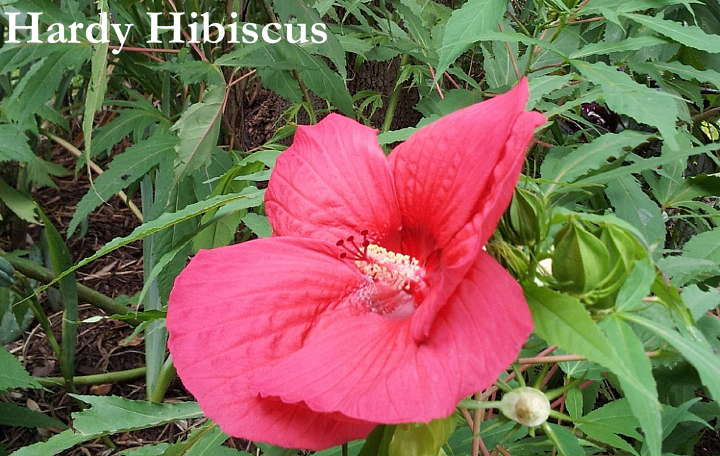
If you have a tropical
hibiscus, remember it is a TROPICAL. They will not tolerate more than a
night or two of light freezes. Even one hard freeze (below 25) could
kill the plant. These plants are native to sunny, warm and usually
humid tropical places.
They detest cold, rainy
weather and cold, wet soil. They will not reliably survive outdoors
north of zone 9. In all other areas, it may be a good idea to bring
them indoors BEFORE temps regularly drop below 40-45 F at night to
avoid any damage.
Treating your tropical
hibiscus correctly will give you years of enjoyment. But remember, they
are not immortal! Some are spent after 4 or 5 years in a pot and should
be tossed away at this point. Try some of the many and never ending new
hybrids being developed!
Getting Tropical Hibiscus
Ready to Come Inside in the Fall/Overwintering Indoors
If you want to keep your
hibiscus and grow them again the next season, you will need
to bring them indoors before the night temps drop much below
40° F. They will need a bright or sunny area, or under
fluorescent lights. The optimum temperatures indoors seem to be between
55 and 70. The cooler end of that temperature range will produce
far fewer insect problems later in the winter. If they are kept in a
greenhouse, keep them cool (55-65) and water when they are dry.
Ideally if you want to bring
your hibiscus indoors to over winter them, they should be grown in pots
outside all season, not planted directly in the ground. The problem
with planting in the ground is that when you dig them up in the fall,
they are weakened by yanking them out of the ground and many times they
will rot before they produce new roots in a pot. They should be kept in
relatively small pots for years (10-14" in diameter is fine). You can
even sink the potted plants in the ground in summer and then just pull
them up , pot and all in the fall, wash off the pot and bring it
inside easily with no shock to the plant in fall.
- Before you bring them
inside, cut back your plant(s) quite a bit, to within 4-5" of the
main stems. This does a few things: it will help eliminate the bugs and
insects that hide in the plants BEFORE they get inside. They like to
hang out in the tips of the branches, in the newest growth. Also remove
any dead leaves, stems., old flowers or debris in the pots, or on the
plants.
- If you want the best
chance of having healthy, vigorous plants with flowers next summer,
your plants need to rest indoors during the shorter days
from October till Feb. or March. DO NOT push them to keep
blooming indoors and leave them full of old foliage.
- After cutting back your
plants, but before they come inside, be sure and hose them
down , making sure to blast the stems, under the leaves, etc. Let
them dry thoroughly and bring them inside. This will eliminate the need
for any insecticide at all. if you must spray, insecticidal soaps and
neem oil work well. Drench the upper and lower parts of the leaves, as
well as the stems and let dry thoroughly outside for a day or so before
they come inside.
- The leaves will
probably turn yellow and fall off when the plants are brought
inside, this is normal. They will regrow when they are ready. In
the meantime, water very sparingly! Do not keep the soil wet. It is
best to let the soil become almost bone dry before soaking it again. Do
not let any water sit under the plants in saucers, etc.
- Your plants will rest
and may not produce new leaves until late February or March. This
is normal too.
- Realize that many
times, hibiscus never bloom well again after the 1st winter
inside. There is not much you can do about this. It appears that
the generic grocery store, Costco, Home Depot, etc., hibiscus tend to
not bloom well again after the 1st season. The new large flowered
hybrids seem to perform much better year after year. This is an
observation based on my experiences over wintering hibiscus. Your
hibiscus experience may vary.
- The other option is to
buy some new hibiscus each year, enjoy their prolific flowers for the
summer and toss them in the fall. That way, you are guaranteed lots of
flowers each summer.
There are people who grow these plants year 'round in the
northern U.S. and Canada, Sweden
and NOT using green houses! Unless you take some extra steps,
such as using artificial
lighting, you can't expect the same lush growth and
bloom quantity when your plants are spending their winters inside and
under less than tropical conditions. But, they will be ready to reward
you for your efforts once they are outside again and the warm weather
arrives. (However, if you do have a greenhouse...)
If you aren't too far north, building this will help and is easy to do.
There are reports of another way of over-wintering these
tropical plants.
Tropical Hibiscus and Their
Environment: Gimme Shelter
Insect and Disease Problems: Don't Bug
Me, I'm Already Sick
Watering and Moisture Tips: Water You
Doing to Your Plant?
Potting and Containers: The Heart and Soil
of the Plant
Repotting and Fertilization: Feeding the
Masses
Getting Ready for Summer: Living in
Paradise
Winter Care: A Shower a Day (or at
least occasionally), Keeps the Aphids at Bay!
Tropical Hibiscus and Their
Environment: Gimme Shelter
Since several hours of temperatures below freezing can be
deadly to hibiscus, before the mercury drops, growers move their potted
plants to an inside location where they will get, perhaps, 3 or 4 hours
of direct sunlight a day. (Supplementing with artificial light (please visit) may also be an option.) Here they
will stay for a few months. Some leaves may turn yellow and drop and
some buds may fall during the adjustment period. If chemical sprays are
used to control insects, these need to be used before the move.
Feel free to prune your hibiscus to fit the space where it
be indoors. It is not important WHERE you make the cuts, as long as
they are made cleanly with a sharp pruner. Just remember that you will
not see much (if ANY) new growth from this pruning.The hibiscus growth
slows down considerably during the late summer/fall and winter.
This is also a good reason NOT to repot in the fall. The
hibiscus will not generate new roots easily at this time of year and
will probably suffer from root rot before it gets re-established.
Insect and Disease Problems: Don't
Bug Me, I'm Already Sick
Once inside, if nothing else is available, soaps such as castile and Murphy Oil Soap or
unscented liquid dishwashing detergents such as Dawn can be used in a one
tbspn per gallon of water solution. These can cause leaf damage which can lead to unhealthy plants -- see this University of Florida advice. Horticultural soaps are recommended. Bigger pots are suggested for longterm use as an inside plant. Nothing
smaller than a 10" pot. Using 14" pots, hibiscus have been known to
thrive for almost 10 years.
Watering and Moisture Tips: Water
You Doing to Your Plant?
Don't over-water, keep on the dry side, but remember that
indoor air may have a drying effect because of low humidity. Misting
the leaves at least daily is desirable in most instances. It may also
be helpful to place each pot on a large tray containing gravel. Fill
the tray with water up to the top of the gravel. As the water
evaporates from the tray, humidity will be higher around the plants,
especially if they are not in drafty areas. Humidifiers are also
beneficial.
To gauge how wet the soil is, try lifting or dragging the pot. Soggy soil is heavy, while nearly dry soil is surpringly light.
Tropical hibiscus do NOT thrive in soil that stays too wet. A small plant with few leaves needs much less water that a
big leafy plant. Do NOT over-water!
Potting and Containers: The Heart
and Soil of the Plant
The soil in pots is very important. The usual "potting
soils" are not recommended. They can be much too heavy and can harden
with a few waterings. One recommendation is to use a light soilless mix
such as PRO-MIX or Sunshine Mix which is available at most
nurseries/garden centers. These are soilless mixtures consisting of
perlite, vermiculite, peat moss, with some bark. Jungle Mix, a
professional seed starting mix, available from some home/garden
centers, also produces good results. Remember that tropical hibiscus do
best with very good drainage.
Repotting and Fertilization:
Feeding the Masses
In late winter, scrape off the top 2 inches of old potting
soil and replace it with fresh soil. You do not have to be gentle; you
will be scraping old roots, too. Go for it! Then add Osmocote slow
release fertilizer "for indoor plants" per the label instructions. At
this same time, prune as severely as you like, using sharp, clean
pruners and just above a node. Occasional use of a 20-20-20 water
soluble fertilizer is also appropriate. The plants will respond
beautifully to this treatment.
Getting Ready for Summer: Living in
Paradise
Once the night temperatures are consistently above about
55° F (13° C) or so, you can think about putting your hibiscus
outside again.
Here's a quick list of things to remember:
• gradually expose your hibiscus plant to the outdoors.
Place your plant in a shady or protected spot for a few days and then
gradually increase the amount of direct sun it receives each day for
about 10 days or so. After that, you can move it to it's final sunny
summer spot. If you don't do this, your hibiscus leaves will fry and
sunburn, just as you would if you were out in the hot sun for 8 hours
without sunscreen after being indoors all winter.
• prune your plant now if you wish to change the shape or
height or induce a bushy flowering plant.
• this is also the time to refresh the soil or repot your
plant if needed (rarely- they love to be potbound!)
• once outside, spray down both lower and upper leaf
surfaces with the garden hose to remove any indoor dust or bugs. You
'll be amazed how it rejuvenates your plant.
• after your plant has been back outdoors for 2 or 3 weeks,
you can start to fertilize again with your favorite fertilzer.
• avoid saucers with standing water under your hibiscus
plants- they can cause root rot and leaf drop.
It's perfectly normal for your plant to have yellow leaves
or even drop some leaves in response to the stress of going back
outside. Different varieties of hibiscus may have their own
"personalities" and may not perform uniformly when conditions change.
If you follow these general guidelines, your plants will be
happy and thrive for many summers.
Winter Care: A Shower a Day,
Keeps the Aphids at Bay!
During the winter indoors, most hibiscus may develop a
problem with aphids or white fly. One of the non-chemical ways to help
with this is to give your hibiscus a shower!
Cover the top of the pot snugly with aluminum foil or
heavy plastic (to keep the soil from washing out and making a mess,
also to prevent waterlogging the roots) and make sure that you
completely seal off the pot around the stem. Then just stick the
plant pot and all in the shower, turn on a low to moderate spray
directly on the leaves. Use lukewarm to comfortably warm (NOT HOT!!)
water.
If you have a movable shower head or attachment so
much the better. Be sure and try to get the undersides of the
leaves if you can. You can even turn the pot on its side if you seal
the top of the pot with the aluminum foil good and tight (use rubber
bands). Do this for about 5-10 minutes.
This may sound extreme, but it sure gives your tired, dusty,
buggy plant new life. Even if you do this only once or twice during the
winter, you will notice a difference.
It will not eliminate the pests but will certainly control
them and your hibiscus will thank you.
If you have questions on these recommendations, you can direct
them to the source,
Boca Joe, for most of the
above information.
| Q&A | brief background | fert.,
insect. | propagation | growing up north | Amer.H.S. | shows | mail list | links |
Back to: Hibiscus Home Page
|

